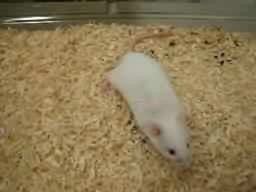 | ||
A reeler is a mouse mutant, so named because of its characteristic "reeling" gait. This is caused by profound hypoplasia of the mouse's cerebellum, in which the normal cerebellar folia are missing. The mutation is autosomal and recessive.
Contents
- Types of reelers
- Key pathological findings in the Reeler brain structure
- Heterozygous Reeler Mouse
- History of research
- References
Cortical neurons are generated normally but are abnormally placed, resulting in disorganization of cortical laminar layers in the CNS. The reason is the lack of Reelin, an extracellular matrix glycoprotein, which during the corticogenesis is secreted mainly by the Cajal-Retzius cells. In the reeler neocortex, cortical plate neurons are aligned in a practically inverted fashion (‘‘outside-in’’). In the ventricular zone of the cortex fewer neurons have been found to have radial glial processes. In the dentate gyrus of hippocampus, no characteristic radial glial scaffold is formed and no compact granule cell layer is established. Therefore, the reeler mouse presents a good model in which to investigate the mechanisms of establishment of the precise neuronal network during development.
Types of reelers
There are two types of the reeler mutation:
In order to unravel the reelin signaling chain, attempts are made to cut the signal downstream of reelin, leaving reelin expression intact but creating the reeler phenotype, sometimes a partial phenotype, thus confirming the role of downstream molecules. The examples include:
Key pathological findings in the Reeler brain structure
Heterozygous Reeler Mouse
Heterozygous reeler mice, also known as HRM, while lacking the apparent phenotype seen in the homozygous reeler, also show some brain abnormalities due to the reelin deficit.
Heterozygous (rl/+) mice express reelin at 50% of wild-type levels and have grossly normal brains but exhibit a progressive loss during aging of a neuronal target of reelin action, Purkinje cells.
The mice have reduced density of parvalbumin-containing interneurons in circumscribed regions of striatum, according to one study.
Studies reveal a 16% deficit in the number of Purkinje cells in 3-month-old (+/rl) and a 24% one in 16-month-old animals: surprisingly this deficit is only present in the (+/rl) males, while the females are spared.
History of research
First mention of reeler mouse mutation dates back to 1951. In the later years, histopathological studies revealed that the reeler cerebellum is dramatically decreased in size and the normal laminar organization found in several brain regions is disrupted (Hamburgh, 1960). In 1995, the RELN gene and reelin protein were discovered at chromosome 7q22 by Tom Curran and colleagues.
